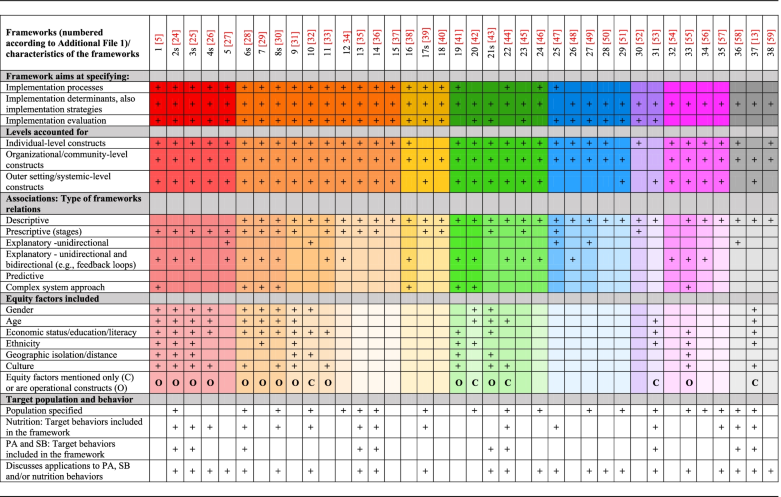
- Note:
s – the frameworks developed by a stakeholder are indicated with ‘s’ after the framework number; PA - physical activit; SB - sedentary behavior (1) The Context and Implementation of Complex Interventions (CICI) framework [5]; (2s) The DPAS (Global Strategy on Diet, Physical Activity and Health) School Policy Framework)
[24]; (3s) Global Strategy on
Diet, Physical Activity and Health: A framework to monitor and evaluate
implementation DPAS:[25]; (4s) Implementing a salt reduction strategy
framework – a practical approach [26]; (5) PRECEDE-PROCEED planning model [27]; (6s) DPAS in
the Eastern Mediterranean Region [28]; (7) Practical, Robust Implementation and Sustainability Model (PRISM)
[29]; (8s) Stepwise approach: Four Steps to Design Public Food Procurement
Initiatives [30]; (9) The pragmatic Ottawa Model of Research Use (OMRU) [31]; (10) Conceptual Model of Evidence-Based Practice Implementation in Public Service Sectors [32]; (11) Conceptual framework of Equity-focused Implementation Research (EquIR) of health programs; [33]; (12) The Nutrition Implementation Framework [34]; (13) Conceptual framework
for designing and implementing health promotion programmes in schools [35]; (14) Not specified [36]; (15) Consolidated Framework for Implementation Research,(CFIR) [37]; (16) Normalization Process Model (NPM) [38]; (17s) a framewowk without a specified name [39]; (18) The Quality Implementation Metaframework (QIF) [40]; (19) ) The Advocacy Coalition
Framework (ACF) [41]; (20) the multilevel implementation quality framework [42]; (21s) Normalization Process Theory [43]; (22) Steps to health: a European framework to promote physical activity for health [44]; (23) Multilevel Implementation Framework (MIF) [45]; (24) The Behavior Change Ball [46]; (25) Implementation science in nutrition framework (ISN) [47]; (26) Promoting Action onResearch Implementation in Health Services (PARiHS) [48]; (27) Organization theory
for determinants of effective implementation of worksite health promotion programs [49]; (28) RE-AIM evaluation model [50]; (29) Framework for a "public health approach"- a global framework for the primary care response to chronic NCDs [51]; (30)
Framework for design and evaluation of complex interventions to improve health [52]; (31) The Implementation Framework [53]; (32) the Interactive Systems Framework for Dissemination and Implementation (ISF) [54]; (33) The He Pikinga Waiora (Enhancing Wellbeing) Implementation Framework [55]; (34) Ecological framework for understanding effective implementation [56]; (35) Comprehensive school health framework (CSH) [57]; (36) Conceptual Framework for Organizational Readiness to Implement Nutrition and Physical Activity Programs [58]; (37) The ANalysis Grid for Environments Linked to Obesity ANGELO [13]; (38) Theoretical Domains Framework (TDF) [59]

